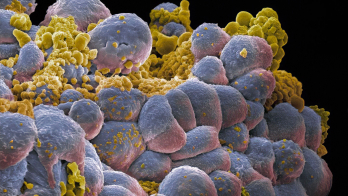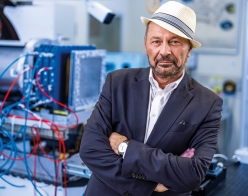
A 132 tonne superconducting magnet has set a new record for whole-body magnetic-resonance imaging (MRI), producing a field of 11.7 T inside a 0.9 m diameter and 5 m long volume. Four-times more powerful than typical hospital devices, the “Iseult” project at CEA-Paris-Saclay paves the way for imaging the brain in unprecedented detail for medical research.
Using a pumpkin as a suitably brain-like subject, the team released its first images on 7 October, validating the system and demonstrating an initial resolution of 400 microns in three dimensions. Other checks and approvals are necessary before the first imaging of human volunteers can begin.
This work will undoubtedly lead to major clinical applications
Stanislas Dehaene
“Thanks to this extraordinary MRI, our researchers are looking forward to studying the anatomical and structural organization of the brain in greater detail. This work will undoubtedly lead to major clinical applications,” said Stanislas Dehaene, director of NeuroSpin, the neuroimaging platform at CEA-Paris-Saclay.
The magnets that drive tens of thousands of MRI devices worldwide perform the vital task of aligning the magnetic moments of hydrogen atoms.Then, RF pulses are used to momentarily disturb this order in a specific region, after which the atoms are pulled back into equilibrium by the magnetic field, and radiate. The stronger the field, the higher the signal-to-noise ratio, and thus better image resolution.
Niobium-titanium
In addition to being the largest and most powerful MRI magnet ever built, claims the team, the Iseult solenoid (carrying a current of 1.5 kA) also sets a record for the highest ever field achieved using niobium-titanium conductor, the same as is used in the present LHC magnets. With various optimisations, and working with the European Union Aroma project on methodologies for optimal functioning of the new MRI device, a resolution approaching 100 to 200 microns is planned, around ten times higher than commercial 3T devices.
Designed and built over ten years, Iseult was jointly led by neuroscientists and magnet and MRI specialists at the CEA Institute of Research into the Fundamental Laws of the Universe (IRFU) and the Frédéric Joliot Institute for Life Sciences, along with several industry and academic partnerships in Germany. Although CERN was not directly involved, Iseult’s success is anchored in more than four decades of joined developments between CERN and the CEA, explains Anne-Isabelle Etienvre, head of CEA IRFU:
“It is thanks to the know-how developed for particle physics and fusion that MRI experts had the idea to ask us to design and build this unique and challenging magnet for MRI — in particular, CEA has played a major role, together with CERN and other partners, on LHC magnets, the ATLAS toroidal magnets and the CMS solenoid,” says Etienvre. “The collaboration between CEA and CERN is still very lively, in particular for advanced magnets for future accelerators.








